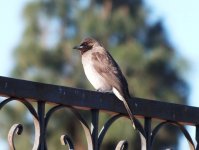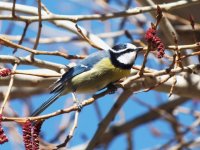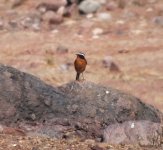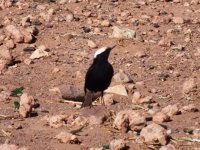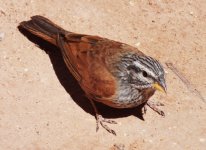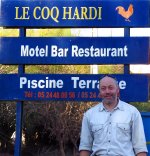dwatsonbirder
Well-known member
Acknowledgements
Many thanks to all those who provided information whilst I was planning this trip, in particular Craig Holden, Richard Moores, Richard Bonser, and all those who replied to my request for info on birdforum. As always special thanks must go to my long -suffering partner Kathi for driving and putting up with my incessant requests to perform U-turns and emergency stops. The trip itself was not specifically a birding trip, and so I took a relaxed approach observing along the way and not going to any of the “classic” sites for target species.
Route taken
Marrakech > Imlil > High Atlas to Ouazazate > Draa valley > Agdz > Ait Ourir > Marrakech
20/2 -22/2 Marrakech
An incredible city with so much going on, the main crux of our time in Marrakech was spent sight-seeing and haggling in the souks. I did manage a few hours on the balcony of our hotel looking for early migrants and I was rewarded with some decent birds. Two new species for me where plentiful and allowed good views; House bunting and Common bulbul (I didn’t count the individual from Spain last spring as I didn’t get good enough views to satisfy all the salient detail for a new species).
Other interesting species noted over our time in Marrakech included Spotless starling, Lesser Kestrel, Short toed eagle, Squacco heron, Pallid and Little swifts.
A visit to the Menara gardens saw another two new species, with the North African forms of magpie (P.p. mauritanica) and Chaffinch (F.c. africana) along with Serin, Sardinian warbler, Cattle egret and White stork.
22/2 Marrakech > Imlil
We headed for the airport to pick up the hire car to begin the touring part of our trip and set off south out of Marrakech towards Imlil – a small laid back town high in the Toubkal National Park. A few species were seen along the drive, with the most interesting birds being elegans Great grey shrike, Crested lark and Sardinian warbler. As we entered the mountainous region we stopped for a break by a river where I located Grey wagtail along with 4 stunning Subpersonata White wagtails. There were also many chiffchaff feeding along the river banks.
We continued our ascent stopping at a cafe about 12km south of Asni for a coffee and to take in the view. African blue tit was another new species and was prospecting a nest sight nearby allowing close approach and good photographic opportunities.
Also in the immediate area where several Black redstart and white wagtail, along with the ubiquitous Common bulbul, African chaffinch, House bunting, Sardinian warbler and chiffchaffs. A Greater spotted woodpecker was seen briefly, but not well enough to identify to subspecies level.
Higher up the valley I encountered the first Black wheatear and Rock bunting of the trip and further Black redstarts. In the evening a familiar sounding call alerted me to the presence of Levaillant’s Green woodpecker calling form the valley below. I did get good but distant views of the bird through the scope, but I only managed one poor photo.
23/2 Imlil > Ouazazate
The next morning I was up early and was rewarded with a mixed flock of Alpine and Common chough on a nearby mountainside, whilst a distant 1cy Golden eagle gave the briefest of views as it soared over the valley. A long drive was ahead today (244km) but it was punctuated by some cracking birds.
On the way down the mountain a quick stop in an interesting looking valley (near to Aguer Sioual) produced a female Rock thrush – one of my favourite species. I did manage a photograph, but I
won’t reproduce it here as it is of terrible quality! More upland species were observed; Raven, Crag martin, Black wheatear, Rock bunting, Black redstart as well as migrant chiffchaffs and white wagtails. We continued along and passed high over the Atlas mountains and began our decent into Ouazazate province and the Draa valley. We headed out south west along the N9 from Ighrem N’ougdal when a brilliant red, black and white flash at the roadside caught my eye. Pulling over, I sprinted back up the road to the field where I’d seen the bird and was rewarded with great views of an adult male Moussier’s redstart – bird of the trip, and a species I have wanted to see for a long time.
Also feeding within the vicinity were a pair of obliging Black wheatear.
After a long drive we finally arrived on the outskirts of Ouarzazate where a pair of Hoopoe lark flew in front of the car, and several Long legged buzzard flew over the suburbs.
24/2 Ouarzazate > Zagora (Draa valley)
Another early start in order to spend the day taking in the Draa valley. More Black wheatear and Long legged buzzard were observed, and a couple of great species gave decent views; Trumpter finch and White crowned black wheatear.
Along the valley several new species for the trip were observed including; Willow warbler, Common snipe, Thekla lark, Cetti’s warbler, Grey heron, House and Rock martin. Careful scanning of roadside wires located a minimum of 13 Palm dove as we drove along the valley, a species still very much on the fringes of the Western Palearctic. A couple of species slipped through the next, and could only be considered as possible; first was a white and black wheatear seen briefly from the roadside near Tinzouline which I’m fairly convinced wasn’t Desert but probably Magreb, alas too quick a view and nowhere near enough detail. The next was a pale sparrow with a harsh call seen in flight without binoculars – Desert sparrow does occur but again I wouldn’t be able to say one way or the other based on the views I had. The valley also held a lot of what looked like good candidates for pure Rock dove. We headed back to spend the evening in Agdz, but not without more great views of white crowned black wheatear.
25/2 Agdz – Ait Ourir
Overnight a Scops owl was heard calling from the hotel grounds. Today we were to head back up the Draa and over the Altas to spend out last night at Ait Ourir before heading back to Marrakech for our lunchtime flight. Our accommodation was right next to the Kasbah in Agdz a wonderful display of Moorish architecture, and also home to white crowned and black wheatears, Blue rock thrush and Black redstart. Leaving our accommodation and heading north towards Ouarzazate we stopped a few times to take in the dramatic scenery, and I was rewarded with good views of Desert lark.
We called in at the spectacular Kasbah at Ait Benhaddou, which has featured in many films and was a stunning place to break up the journey. In the area were white crowned, black and desert wheatears along with further Desert larks.
Once again entering the high Atlas we were rewarded with more stunning scenery and good views of Chough and Alpine chough, White wagtail and African Chaffinch.
We continued along the road to our last destination, Ait Ourir where we spend our last night at the suggestively named “Le Coq Hari” which had lush gardens filled with migrants. Hirundines and Common kestrels hawked overhead, Common bulbul and blackbird sang harmoniously, and chiffchaffs, blackcaps and Sardinian warblers flicked about in the bushes. There were a couple of surprises as well; a Song thrush broke cover (I didn’t realise they wintered this far south) and one of the most surreal moments came as a cuckoo began to call in the evening light!
The last morning was spent driving to Marrakech, with much the same mixture of species, and after a hellish drive through rush hour Marrakech we were on our flight home.
Morocco has a lot to offer the birder, with some great specialists and regional endemics, the spectacle of migration, and also the possibility of finding something very rare (White cheeked bee-eater or Slender billed curlew anybody?)
I don’t believe this trip did the regions birds justice, as most birds were observed from the roadside for a matter of 5minutes or so, and a dedicated birding trip in the future I feel is inevitable for me. It is still a breathtaking country to visit, and offers something different from the classic European destinations, and also with no rain and temperatures in the mid 20’s for a whole week, it was a welcome relief from the relentless British low pressure system fest that is winter ‘13/’14. Thoroughly recommended!
Many thanks to all those who provided information whilst I was planning this trip, in particular Craig Holden, Richard Moores, Richard Bonser, and all those who replied to my request for info on birdforum. As always special thanks must go to my long -suffering partner Kathi for driving and putting up with my incessant requests to perform U-turns and emergency stops. The trip itself was not specifically a birding trip, and so I took a relaxed approach observing along the way and not going to any of the “classic” sites for target species.
Route taken
Marrakech > Imlil > High Atlas to Ouazazate > Draa valley > Agdz > Ait Ourir > Marrakech
20/2 -22/2 Marrakech
An incredible city with so much going on, the main crux of our time in Marrakech was spent sight-seeing and haggling in the souks. I did manage a few hours on the balcony of our hotel looking for early migrants and I was rewarded with some decent birds. Two new species for me where plentiful and allowed good views; House bunting and Common bulbul (I didn’t count the individual from Spain last spring as I didn’t get good enough views to satisfy all the salient detail for a new species).
Other interesting species noted over our time in Marrakech included Spotless starling, Lesser Kestrel, Short toed eagle, Squacco heron, Pallid and Little swifts.
A visit to the Menara gardens saw another two new species, with the North African forms of magpie (P.p. mauritanica) and Chaffinch (F.c. africana) along with Serin, Sardinian warbler, Cattle egret and White stork.
22/2 Marrakech > Imlil
We headed for the airport to pick up the hire car to begin the touring part of our trip and set off south out of Marrakech towards Imlil – a small laid back town high in the Toubkal National Park. A few species were seen along the drive, with the most interesting birds being elegans Great grey shrike, Crested lark and Sardinian warbler. As we entered the mountainous region we stopped for a break by a river where I located Grey wagtail along with 4 stunning Subpersonata White wagtails. There were also many chiffchaff feeding along the river banks.
We continued our ascent stopping at a cafe about 12km south of Asni for a coffee and to take in the view. African blue tit was another new species and was prospecting a nest sight nearby allowing close approach and good photographic opportunities.
Also in the immediate area where several Black redstart and white wagtail, along with the ubiquitous Common bulbul, African chaffinch, House bunting, Sardinian warbler and chiffchaffs. A Greater spotted woodpecker was seen briefly, but not well enough to identify to subspecies level.
Higher up the valley I encountered the first Black wheatear and Rock bunting of the trip and further Black redstarts. In the evening a familiar sounding call alerted me to the presence of Levaillant’s Green woodpecker calling form the valley below. I did get good but distant views of the bird through the scope, but I only managed one poor photo.
23/2 Imlil > Ouazazate
The next morning I was up early and was rewarded with a mixed flock of Alpine and Common chough on a nearby mountainside, whilst a distant 1cy Golden eagle gave the briefest of views as it soared over the valley. A long drive was ahead today (244km) but it was punctuated by some cracking birds.
On the way down the mountain a quick stop in an interesting looking valley (near to Aguer Sioual) produced a female Rock thrush – one of my favourite species. I did manage a photograph, but I
won’t reproduce it here as it is of terrible quality! More upland species were observed; Raven, Crag martin, Black wheatear, Rock bunting, Black redstart as well as migrant chiffchaffs and white wagtails. We continued along and passed high over the Atlas mountains and began our decent into Ouazazate province and the Draa valley. We headed out south west along the N9 from Ighrem N’ougdal when a brilliant red, black and white flash at the roadside caught my eye. Pulling over, I sprinted back up the road to the field where I’d seen the bird and was rewarded with great views of an adult male Moussier’s redstart – bird of the trip, and a species I have wanted to see for a long time.
Also feeding within the vicinity were a pair of obliging Black wheatear.
After a long drive we finally arrived on the outskirts of Ouarzazate where a pair of Hoopoe lark flew in front of the car, and several Long legged buzzard flew over the suburbs.
24/2 Ouarzazate > Zagora (Draa valley)
Another early start in order to spend the day taking in the Draa valley. More Black wheatear and Long legged buzzard were observed, and a couple of great species gave decent views; Trumpter finch and White crowned black wheatear.
Along the valley several new species for the trip were observed including; Willow warbler, Common snipe, Thekla lark, Cetti’s warbler, Grey heron, House and Rock martin. Careful scanning of roadside wires located a minimum of 13 Palm dove as we drove along the valley, a species still very much on the fringes of the Western Palearctic. A couple of species slipped through the next, and could only be considered as possible; first was a white and black wheatear seen briefly from the roadside near Tinzouline which I’m fairly convinced wasn’t Desert but probably Magreb, alas too quick a view and nowhere near enough detail. The next was a pale sparrow with a harsh call seen in flight without binoculars – Desert sparrow does occur but again I wouldn’t be able to say one way or the other based on the views I had. The valley also held a lot of what looked like good candidates for pure Rock dove. We headed back to spend the evening in Agdz, but not without more great views of white crowned black wheatear.
25/2 Agdz – Ait Ourir
Overnight a Scops owl was heard calling from the hotel grounds. Today we were to head back up the Draa and over the Altas to spend out last night at Ait Ourir before heading back to Marrakech for our lunchtime flight. Our accommodation was right next to the Kasbah in Agdz a wonderful display of Moorish architecture, and also home to white crowned and black wheatears, Blue rock thrush and Black redstart. Leaving our accommodation and heading north towards Ouarzazate we stopped a few times to take in the dramatic scenery, and I was rewarded with good views of Desert lark.
We called in at the spectacular Kasbah at Ait Benhaddou, which has featured in many films and was a stunning place to break up the journey. In the area were white crowned, black and desert wheatears along with further Desert larks.
Once again entering the high Atlas we were rewarded with more stunning scenery and good views of Chough and Alpine chough, White wagtail and African Chaffinch.
We continued along the road to our last destination, Ait Ourir where we spend our last night at the suggestively named “Le Coq Hari” which had lush gardens filled with migrants. Hirundines and Common kestrels hawked overhead, Common bulbul and blackbird sang harmoniously, and chiffchaffs, blackcaps and Sardinian warblers flicked about in the bushes. There were a couple of surprises as well; a Song thrush broke cover (I didn’t realise they wintered this far south) and one of the most surreal moments came as a cuckoo began to call in the evening light!
The last morning was spent driving to Marrakech, with much the same mixture of species, and after a hellish drive through rush hour Marrakech we were on our flight home.
Morocco has a lot to offer the birder, with some great specialists and regional endemics, the spectacle of migration, and also the possibility of finding something very rare (White cheeked bee-eater or Slender billed curlew anybody?)
I don’t believe this trip did the regions birds justice, as most birds were observed from the roadside for a matter of 5minutes or so, and a dedicated birding trip in the future I feel is inevitable for me. It is still a breathtaking country to visit, and offers something different from the classic European destinations, and also with no rain and temperatures in the mid 20’s for a whole week, it was a welcome relief from the relentless British low pressure system fest that is winter ‘13/’14. Thoroughly recommended!




